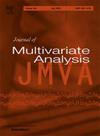树Pólya分裂分布的多变量计数数据
IF 1.4
3区 数学
Q2 STATISTICS & PROBABILITY
引用次数: 0
摘要
在本文中,我们开发了一类新的适合计数数据的多变量分布,称为Tree Pólya Splitting。该类由沿固定划分树的单变量分布和奇异多变量分布组合而成。已知分布,包括dirichlet -多项式,广义dirichlet -多项式和dirichlet -树多项式,都是这类的特殊情况。正如我们将演示的那样,这些分布提供了一些灵活性,允许在观察级别对复杂的依赖结构(正、负或null)进行建模。具体来说,我们通过主要关注边际分布、阶乘时刻和依赖结构(协方差和相关性)来介绍Tree Pólya分裂分布的理论性质。一方面,我们使用了丰富的Trichoptera数据集作为基准来说明本文中开发的理论特性,另一方面,通过将这些模型与其他拟合多变量数据的方法进行比较,例如生态学中的泊松-对数正态模型或微生物分析中使用的奇异多变量分布,我们展示了这些类型模型的兴趣。本文章由计算机程序翻译,如有差异,请以英文原文为准。
Tree Pólya Splitting distributions for multivariate count data
In this article, we develop a new class of multivariate distributions adapted for count data, called Tree Pólya Splitting. This class results from the combination of a univariate distribution and singular multivariate distributions along a fixed partition tree. Known distributions, including the Dirichlet-multinomial, the generalized Dirichlet-multinomial and the Dirichlet-tree multinomial, are particular cases within this class. As we will demonstrate, these distributions offer some flexibility, allowing for the modeling of complex dependence structures (positive, negative, or null) at the observation level. Specifically, we present theoretical properties of Tree Pólya Splitting distributions by focusing primarily on marginal distributions, factorial moments, and dependence structures (covariance and correlations). A dataset of abundance of Trichoptera is used, on one hand, as a benchmark to illustrate the theoretical properties developed in this article, and on the other hand, to demonstrate the interest of these types of models, notably by comparing them to other approaches for fitting multivariate data, such as the Poisson-lognormal model in ecology or singular multivariate distributions used in microbial analysis.
求助全文
通过发布文献求助,成功后即可免费获取论文全文。
去求助
来源期刊

Journal of Multivariate Analysis
数学-统计学与概率论
CiteScore
2.40
自引率
25.00%
发文量
108
审稿时长
74 days
期刊介绍:
Founded in 1971, the Journal of Multivariate Analysis (JMVA) is the central venue for the publication of new, relevant methodology and particularly innovative applications pertaining to the analysis and interpretation of multidimensional data.
The journal welcomes contributions to all aspects of multivariate data analysis and modeling, including cluster analysis, discriminant analysis, factor analysis, and multidimensional continuous or discrete distribution theory. Topics of current interest include, but are not limited to, inferential aspects of
Copula modeling
Functional data analysis
Graphical modeling
High-dimensional data analysis
Image analysis
Multivariate extreme-value theory
Sparse modeling
Spatial statistics.
 求助内容:
求助内容: 应助结果提醒方式:
应助结果提醒方式:


